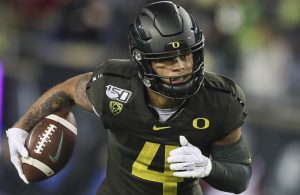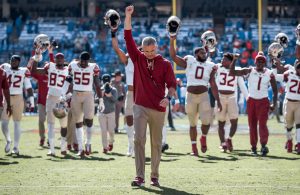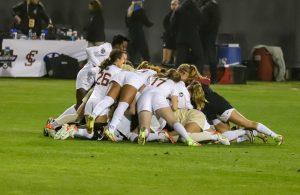- Sunday Seminole Summary: FSU Football Adds Pair of WR Transfers
- Sunday Seminole Summary: FSU Football Exits ESD With Top-15 Class
- Sunday Seminole Summary: FSU Soccer Tops BYU for Third National Championship
- Sunday Seminole Summary: FSU Soccer Advances to National Championship Match
- Seminole Sunday Summary: FSU Soccer Heads Back to College Cup
- Seminole Sunday Summary: FSU Soccer Reaches Sweet 16; Football Tops Boston College
- Seminole Sunday Summary: FSU Soccer Wins ACC, Advances to Second Round of NCAA Tournament; FSU Football Rallies Past Miami
- Seminole Sunday Summary: FSU Soccer Tops Wake on OT to Advance to ACC Final
- Seminole Sunday Summary: FSU Football Crushes UMass for Third Straight Win
- Seminole Sunday Summary: FSU Soccer Stays Perfect with Pair of Wins
Biggest Strength/Weakness for FSU Combine Participants
- By Clint Eiland
- Updated: February 23, 2017
 Jeff Romance/FSU athletics
Jeff Romance/FSU athleticsJust one week remains until the NFL Combine is set to begin in Indianapolis. Included in the action will be eight different Florida State players, who have ensured that FSU now has the most all-time combine participants of any college.
In addition to our pre-combine round projections, The Daily Nole breaks down the biggest strength and weakness of each FSU prospect heading into next week.
Dalvin Cook, RB
Strength:Â Acceleration
There are certain traits that can’t be taught when playing football. Having a “fifth gear” is one of those. Just when you think Dalvin Cook has reached top speed, or when you think a defender has a good angle on him, he goes into the fifth gear and streaks ahead of everyone. This even applies to the non-“home run” plays. When he’s at the line of scrimmage and trying to just get positive yards, he patiently waits for a hole to develop. Then he bursts through for a guaranteed three yards at minimum. Â It’s a trait that very few players have, and it has a very successful transition from college to the pros. Truthfully, Cook has so many positive traits that it’s hard to choose just one. But his explosion is something rarely seen in football, and for its rareness, it gets the spotlight.
Weakness: Fumbles
If there is one aspect that Cook will truly have to work on in the NFL, it is ball security. He’s gotten better every year at it while playing for Florida State, but he still maintains a high fumble rate relative to fellow running back draft prospects. They always seem to come at inopportune times — whether in a high profile bowl game or in a close contest, Cook lets the ball hit the ground at an alarming rate. Thankfully for him, the 2016 season only had four fumbles lost, and they all came in two games. Cook however, still had six fumbles in 13 games, which is a bit more than scouts would like to see. It won’t affect his stock much (if at all). Though it will be noted.
DeMarcus Walker, DE
Strength: Polished Technique
Players who have solid technique when drafted will likely make immediate impacts at whatever team they go to. There’s simply less of a coaching aspect needed to put them on the field. This applies to Walker, who already has an array of pass-rushing moves that make him an enticing prospect for coaches wanting a player to produce on Day 1. Walker almost never gets abused at the line and is also very good at filling gaps, even if he doesn’t make the play. He’s the definition of a very sound technical player, hence why he was able to rack up prolific numbers against elite competition while at FSU.
Weakness: Low Ceiling
Prospects like Jadeveon Clowney have shown how potential can be worth the risk. So when incredibly athletic players like Myles Garrett and Malik McDowell are in the same draft class, they will almost certainly get picked above a player like Walker, who doesn’t necessarily have the sky-high potential they do. Walker has already filled out his frame and doesn’t have much room to grow. A team can’t build around Walker like they can Garrett or McDowell. One also wonders what type of line Walker could fit best on, since he’s slightly big for a 4-3 end but small for a 3-4 end.
Roderick Johnson, T
Strength: Physical Tools
Everything is there for Roderick Johnson to become a successful NFL starter. He’s tall (6-7), heavy (311 pounds), has long arms, and possesses surprising quickness. He showed that he can utilize his power in both the pass-blocking and run-blocking game. He doesn’t look like he’s maxed out his frame either, so there is a lot to love about Johnson from a physical perspective. If he gets properly coached, Johnson can be a long-term option at offensive tackle. There’s no worry about potential or future capabilities.
Weakness: Inconsistency
Johnson has experienced a slide in his draft stock because teams are unsure which Johnson will show up in the NFL. Will it be the one who establishes his feet, extends his arms, and perfectly blocks the defensive end? Or will it be the one who gets out of balance, loses his assignment, and lets his quarterback get clobbered? He never exactly lived up to the hype from his freshman year, largely because he didn’t seem to actually improve from a technique standpoint. That proved to be costly. Certain defenders found out his weaknesses and were able to exploit them to great success.
Marquez White, CB
Strength: Length
It was actually impressive to see how White used his general length (32-inch arms and 10-inch hands) as a cornerback. His ball skills were never particularly noteworthy, but he could jam receivers and bat passes near the line exceptionally well. He’s around average height for an NFL cornerback, meaning he has to make up for it somehow. His wingspan just does that. It’s deceptive and while he never had too many stats from his college days, he could utilize it in the league to pick off close passes or to bat down balls that other corners might not be able to reach.
Weakness: Lack of Strength
Bigger receivers still gave White some problems throughout his college career (Mike Williams being a prime example). It wasn’t so much their height or vertical ability that punished him, it was physicality. White is still a very physical player, but he simply doesn’t have the size to battle with stronger receivers. He was able to get away with this in college due to the level of competition that he was facing. This might not be a deal-breaker, since he likely won’t be tasked with going up against No. 1 receivers, but it does set a ceiling on what type of cornerback he could be.
Freddie Stevenson, FB
Strength: Lead Blocking
Fullbacks have a hard time getting drafted. They need to show exceptional skill in at least one area to justify using a pick on them. Luckily for Stevenson, his lead-blocking ability might actually do that. Throughout his career, Stevenson was fantastic at engaging defenders at the line and giving his backfield mates a hole to run through. Teams who like to hit the middle will be interested in Stevenson’s services.
Weakness: Lack of Production
Even when one considers that Stevenson was a fullback, his production compared to fellow draft peers is below average. While the five touchdowns are good, the 90 rushing yards and 14 receiving yards don’t pop out. Any team looking to draft Stevenson either already knows how they’re going to use him, or is taking a risk hoping that he can become at least an average NFL fullback.
Travis Rudolph, WR
Strength: Football IQ
The strongest aspect of Rudolph’s game coming out of high school is still his strongest aspect when heading to the NFL. Rudolph is a crisp route-runner who always provides a reliable target for whatever quarterback is under center. He went through four different passers in three years (each with wildly different styles) and he still found ways to make an impact. For two straight years he was far and away the leading receiver for FSU. Rudolph picked up the playbook very quickly and can provide a team with an immediate contributor if they need one.
Weakness: Low Ceiling
Despite his consistent production, Rudolph never really seemed to take the next step as a receiver. Instead of becoming a clear No. 1 who receives the majority of the targets, he was actually getting outpaced by Jesus Wilson before the foot injury. He simply doesn’t seem to excel in any physical aspect of his game. He has no serious weaknesses, and he can make highlight plays when given the opportunity (Florida 2016, Syracuse 2015). Yet he has likely reached his ceiling as a receiver, and that seems to be the level of a decent No. 2 or strong No. 3 in the NFL.
Kermit Whitfield, WR
Strength: Speed
It is very possible that the 40-yard dash record is broken this year. That’s because Kermit Whitfield is participating in the combine. While he was never expected to be a complete wide receiver, Whitfield made decent contributions in 2015 and 2016 at the position. His speed was still jaw-dropping to watch. If the defense gave him open space, he was gone. Even when defenders were in the right place, he gained extra yards by purely dashing forward with extra effort. There’s little doubt that some teams are going to fall in love with what he can do as a returner or situational receiver, whether it be in the draft or through free agency.
Weakness: Limited Use
Unless Whitfield develops into something unseen at Florida State, he will be a No. 3 receiver or simply a return specialist. He’s less of a receiver and more of a sprinter, which is a trait he can certainly use to his advantage in the NFL. The problem is that his ball-pinpointing skills, route-running, and small size mean he has an uphill battle to crack a starting rotation.
Jesus Wilson, WR
Strength: Quickness
He doesn’t have the top-end speed of fellow receiver Whitfield, but Jesus Wilson has always possessed quickness. It usually appears when he immediately breaks after catching the ball, and it often times catches cornerbacks off guard. Rarely does it result in a huge touchdown or highlight play, but it does allow him to gain extra yards down the field. Wilson got better at catching and route-running throughout his career, and it finally helped his most evident natural talent shine through.
Weakness: Lack of Size
Wilson is too small to ever be more than a third option at wide receiver. He barely reaches 5-10 and isn’t more than 185 pounds. That being said, he is a more complete receiver than a return specialist like Whitfield, so he has a higher chance to contribute sooner. The size issue however, is still too much of a downside for many teams.




You must be logged in to post a comment Login